How a Labor Lawyer Sees MLB’s Latest Lockout Tactic

When Rob Manfred wrote his letter to “our Fans” on Dec. 2, he explained Major League Baseball’s decision to lock out the players as a tactic to “jumpstart the negotiations and get us to an agreement that will allow the season to start on time.”
Then, the league went 43 days without making a proposal to the MLB Players’ Association. So much for being “ready to work around the clock to meet that goal.”
Yesterday afternoon, two months after the previous collective bargaining agreement expired and the lockout began, MLB requested a federal mediator to help resolve its dispute with the union. It also informed the players that it would not be making a counter offer to their latest proposal after two days earlier telling them it would. That’s it. The two sides met four times to bargain over core economics and made little progress, only for the league to say it has exhausted most of its options and its only choice is to seek outside assistance.
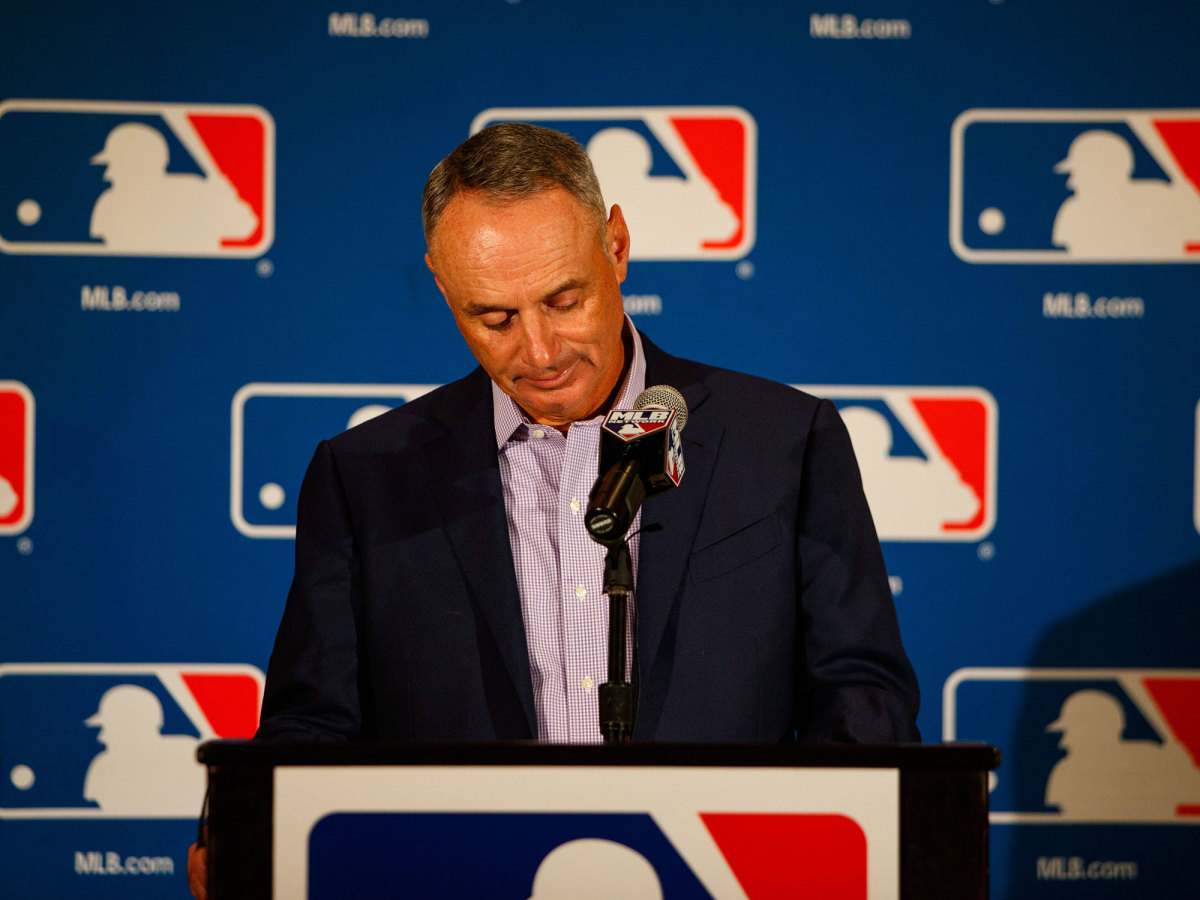
Why Mediation?
At first glance, it would appear that mediation is a good thing. Why not enlist a neutral party to help the two parties come to an agreement? That’s the reaction the league wants us to have. Federal mediation for private industries is voluntary, so the union has to agree to the league’s request. So, if the players don’t accept mediation, the league can frame it as the union’s unwillingness to play ball.
That’s exactly what happened when the union rejected mediation this afternoon. An MLB spokesperson said in a statement, “It is hard to understand why a party that wants to make an agreement would reject mediation from the federal agency specifically tasked with resolving these disputes, including many successes in professional sports.”
The spokesperson did not mention the last time mediation was used in baseball. The owners and players brought in a mediator to help them resolve their disagreements during the 1994 strike, and that didn’t help. Representatives from both sides, including Manfred, who at the time was working as MLB’s outside counsel, told The Athletic in 2019 that it was an utter disaster. The PA is cognizant of its previous experience with a mediator; for this and other reasons that we’ll get into below, the union rejected the request for mediation this afternoon.
This morning I spoke with Eugene Freedman, a labor lawyer who also writes about baseball labor relations, to get a better understanding of what federal mediation is, why the league requested it and what this could mean for the CBA negotiations and, ultimately, the 2022 season.
Freedman has worked with a number of federal mediators over the years and he explained that mediation can help resolve labor disputes that reach dead ends. For example, Scot Beckenbaugh, Deputy Director of the Federal Mediation and Conciliation Service, was the mediator during the 2012–13 NHL lockout, and both sides attributed their eventual agreement to Beckenbaugh’s assistance.
“Mediation usually isn’t engaged early in the bargaining process,” Freedman said. “I wouldn’t say that they’re deeply engaged in negotiations yet. It seems like the parties have not reached a natural conclusion where a mediator would be of assistance. They seem to be making baby steps toward each other, but they still haven’t engaged on a lot of the core issues. So mediation, I would say, is premature.”
There are two ways to interpret MLB’s intentions for requesting mediation. The first is that the league actually views it as the best way to get the two sides to come to a fair agreement as soon as possible. Initially, Freedman was hopeful this was the case, even if he thought it was relatively early in the process.
He pointed at management’s lack of discipline at the bargaining table as a reason for why bringing in an independent mediator would make sense. Bargaining sessions are supposed to work like this: the two sides each have a group of members representing them, and only a few specific people from each bargaining team are responsible for leading the discussion. Everyone else at the table should be silent.
“When you have these potential novices at the table making statements, it’s not healthy for the actual bargaining, and it also could hurt your own side,” Freedman said. As an example, he paraphrased what Rockies owner Dick Monfort reportedly said at the table last week, Some owners can’t afford their teams because of all these other costs.
Woof. That’s not going to help the owners’ case. So, at first, Freedman thought maybe the league’s lead negotiator, Dan Halem, was trying to get the owners—his own side—to move off some of their unrealistic proposals. If that were true, though, Bruce Meyer, the union’s chief negotiator, would have known this was the league’s rationale.
“This was an ambush,” Freedman said. “They put it out publicly without talking to the union about it.”
‘Additional Legal Weapons’ for MLB
This leads to the second, more cynical interpretation: MLB is trying to reach an impasse, when neither side can negotiate further and they still don’t have a deal, as soon as possible. Upon reaching an impasse, the league “gains additional legal weapons,” Freedman said, the most lethal of which would be for the owners “to unilaterally impose their last, best offer.”
That happened after mediation failed in December 1994. That last, best offer MLB made and implemented offers a glimpse of how bad an impasse would be, and reveals the intentions of management.
As The Washington Post reported then, “Last night the owners declared an impasse in negotiations and put a salary cap system into place…”
“Following a phase-in period, teams will have to devote between 84 and 110 percent of the average major league payroll to player compensation. The salary arbitration system will be eliminated. Players will be eligible to become restricted free agents after four seasons of major league service time, and unrestricted free agents following six years.”
Ultimately, this did not stand. The union filed an unfair labor practice charge to the National Labor Relations Board, which sided with the players and issued a complaint against the owners, claiming that all of the changes the owners instituted had to be collectively bargained. The case was heard by Supreme Court Justice Sonia Sotomayor, who was then a district court judge. She ruled in favor of the players and restored the status quo of the previous CBA while the two sides continued to negotiate. In response, the players ended their strike.
Freedman said any impasse likely wouldn’t stand if the owners declared it, at least not at this point.
“Right now, I would say the fact that they’re still meeting regularly and making proposals is quite inconsistent with the idea that they would be at impasse,” Freedman said. “If the parties both declared publicly, ‘We have nowhere else to go,’ they would be at impasse. But they’re making proposals; they’re making progress, albeit small progress. All of those things are indicative that this is not impasse and they aren’t even close to impasse.”
Fans Get Caught Looking
So what does this all mean? To use a baseball phrase, MLB’s request for federal mediation is eyewash. It was meant to get the public to turn against the players and break the union’s resolve. If the players agreed to mediation, the league would get a mediator to move the sides to the midpoint from where they are now. That midpoint likely would favor the owners, because the union’s goal is to drastically alter the economic structure of the sport. Any mediator-assisted agreement most certainly wouldn’t do that. Then, if no agreement was reached after mediation, the league would declare an impasse, end the lockout and implement a season under the conditions most favorable to the owners. The players could respond by filing a charge like it did in 1994, but the litigation that would follow would take time. And with the lockout over, they’d be expected to return to work. They could then go on strike, creating another work stoppage, but that wouldn’t make their case look better to the fans who just want to enjoy baseball again.
For the moment, though, that’s not going to happen because the union rejected mediation. “After consultation with our Executive Board, and taking into account a variety of factors, we have declined this request,” the MLBPA said in a statement. “The clearest path to a fair and timely agreement is to get back to the table. Players stand ready to negotiate.”
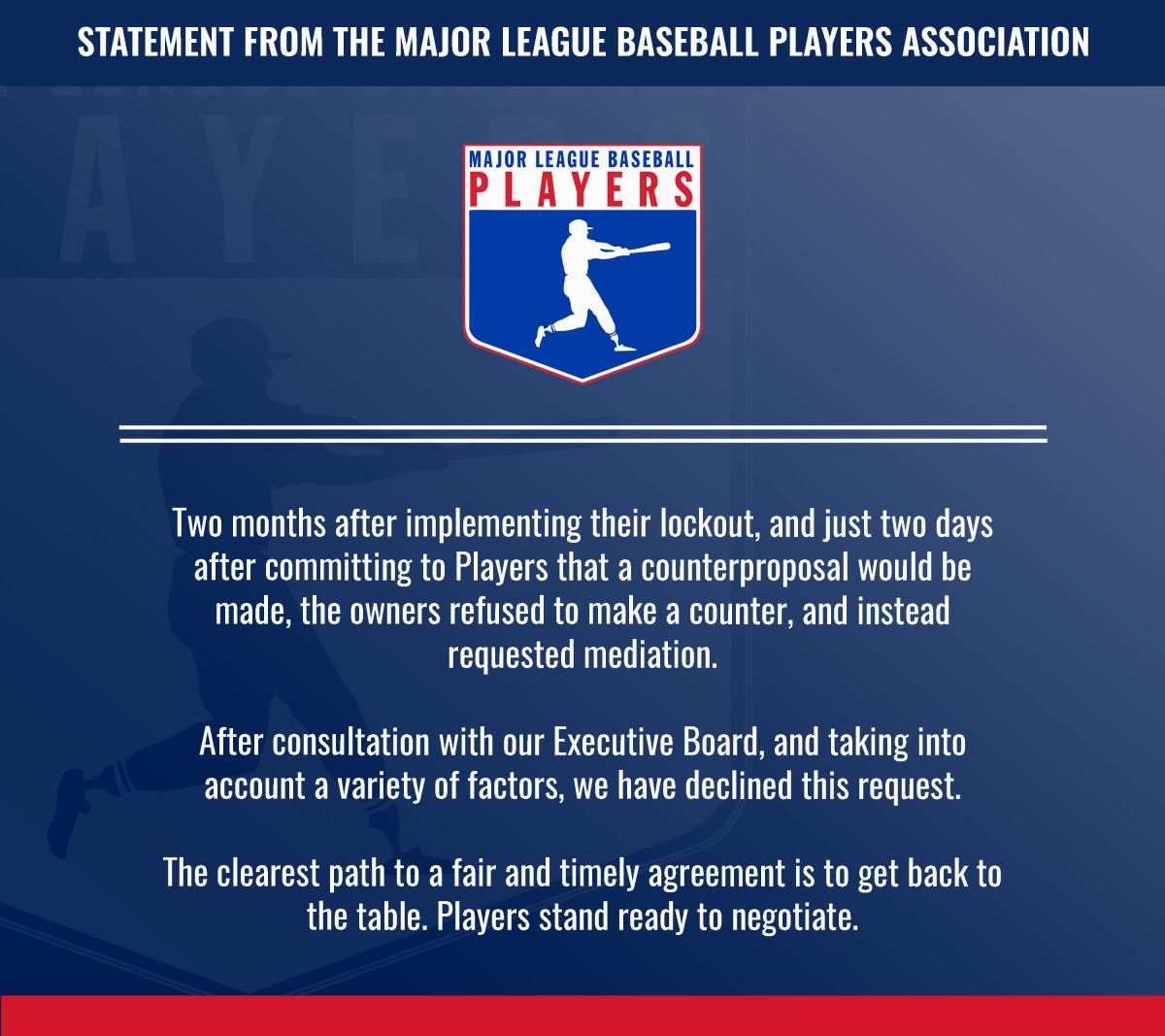
MLB said in its statement that it “remains committed to offering solutions at the table and reaching a fair agreement for both sides.” No additional bargaining sessions have been scheduled at this time. Let’s just hope MLB doesn’t take another 43-day vacation before making its next offer. Remember, it is the league that is responsible for the current lockout and for jeopardizing the cancellation of games. It’s the owners who locked out the players.
In his letter, Manfred said the owners locked out the players to speed up negotiations so that the 2022 season would not be delayed. “We all owe you, our fans, better than that.”
Yes, yes you do.
Have any questions for our team? Send a note to mlb@si.com.
1. THE OPENER
“When Major League Baseball owners reached out to a federal mediator for help Thursday, it was a commentary on more than just two months of fruitless talks with the players to end the lockout. It also reflected how the two sides have agreed on virtually nothing for the past three years.”
That’s how Tom Verducci begins his alarming column from today about the lockout. In it, he writes: “At the glacial rate of these lockout talks and three years at loggerheads, the start of the season, not just pitchers and catchers, is in jeopardy.”
You can read Tom’s entire story here.
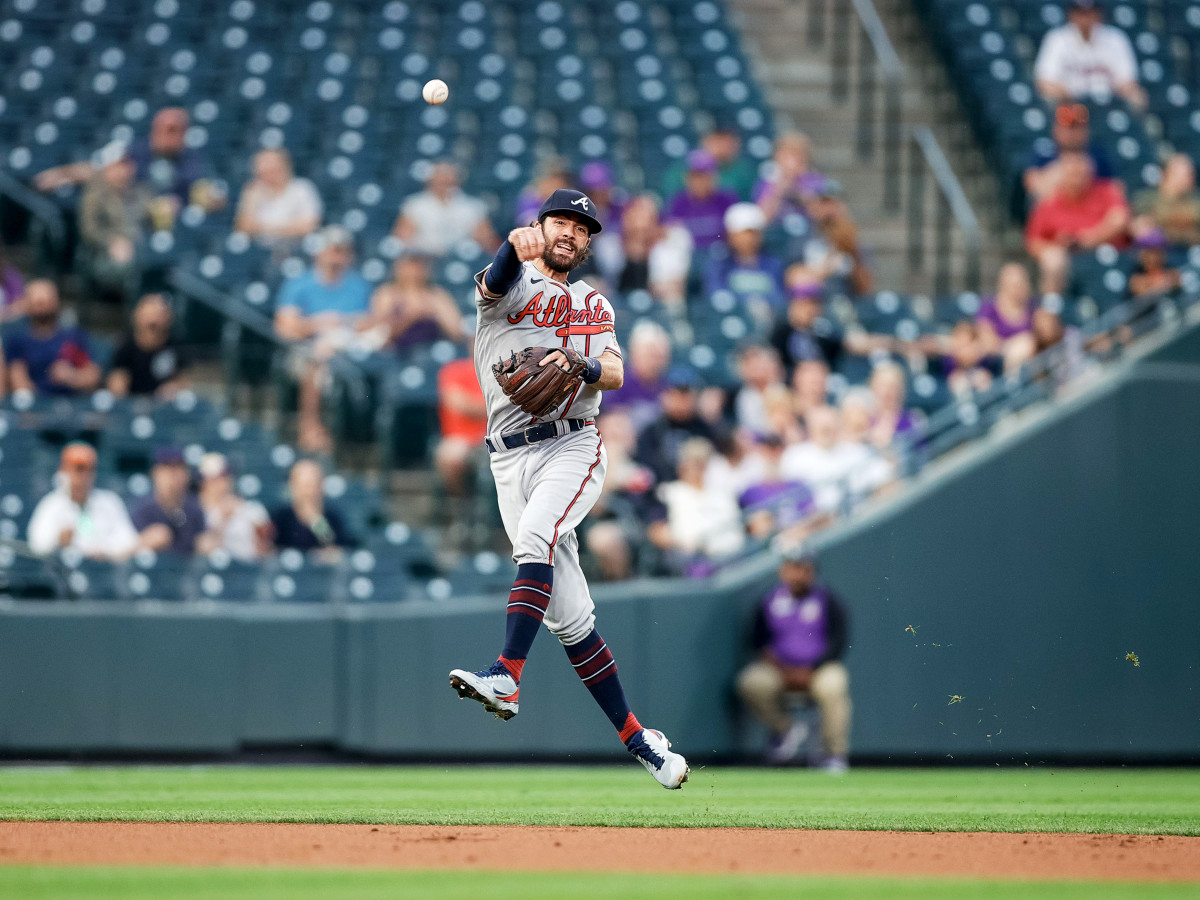
2. ICYMI
If you’re tired of the lockout coverage and want to read a between-the-lines baseball story for a change, I suggest you read Verducci’s column from Wednesday. It’s an insightful look at the death of ground balls in baseball… and the culprits are not just launch angle and the love of the home run.
The Death of Ground Balls by Tom Verducci
After the Hall of Fame results were announced on Jan. 26, Will Laws started looking at the current players with interesting Cooperstown cases. Across three stories, published last Friday, Monday and Tuesday, Will put together a team of active borderline HOFers.
For those of us who love talking about the Hall (as I assume most Five-Tool readers do), it’s worth checking out.
Active Infielders Closest to the Cooperstown Cut Line by Will Laws
Active Outfielders Closest to the Cooperstown Cut Line by Will Laws
Active Pitchers and DHs Closest to Cooperstown Cut Line by Will Laws
On Wednesday, an Orange County Appeals court reinstated a defamation suit filed against the Angels by Brian “Bubba” Harkins. You may remember Bubba from last year when MLB’s “sticky stuff” scandal broke. An Angels employee of 38 years, Harkins was fired suddenly on March 3, 2020.
Stephanie Apstein and Alex Prewitt told Harkins’s story in their June 14 Daily Cover story. Here’s what they wrote:
“Harkins says that [then-Angels GM Billy] Eppler handed him a copy of a league memo issued less than a week earlier declaring that team employees were “strictly prohibited from providing, applying, creating, concealing, or otherwise facilitating the use of foreign substances by players on the field.” Then Eppler informed Harkins that an MLB investigation had concluded he had violated these rules, and that he was fired.
“I said, ‘Billy, you’re firing me over something that’s all over your clubhouse right now,’” Harkins tells Sports Illustrated in his first interview since that day. “He didn’t say a word to me. He got up from the table, walked out and left the rest of the meeting with the Angels’ lawyer.”
Harkins remains stunned at his status as the first—and so far only—casualty of MLB’s recent war on pitch doctoring. He does not deny the allegations; he readily admits that he’d been supplying both Angels and opposing pitchers for more than a decade with his home-cooked mixture of liquid pine tar, solid pine tar (often called Mota stick) and rosin. He claims he’d done special orders for some of the biggest names in the game, including Nationals ace Max Scherzer and Yankees ace Gerrit Cole, then with the Astros.”
He Made Sticky Stuff for MLB Pitchers for 15 Years. Now He's Speaking Out. by Stephanie Apstein and Alex Prewitt
3. WORTH NOTING
Major League Baseball could end the lockout at any time, regardless of the involvement of a federal mediator, if it actually wanted to do so. Freedman told me this morning, “If management maintains the lockout, it’s management that’s cancelling spring training and/or regular season games.”
So what would that look like? The two sides would continue to bargain but the players wouldn’t be locked out. They could go to spring training as soon Feb. 16, when pitchers and catchers are scheduled to report, and the 2022 season could begin on time. The sport would operate under the previous CBA, because of status quo protections, until the league and union agreed to a new one.
One thing that would change is the competitive balance tax, which had a sunset provision and expired at the end of the regular season, said Freedman, meaning if the league lifted the lockout, “Steve Cohen could theoretically sign every free agent that fit on his 40-man roster without limitation.”
Wouldn’t that be something?
4. TRIVIA!
Before we get into this week’s question, here is the answer to the one I asked last Friday.
Last Week’s Question: David Ortiz is one of six players to hit at least 450 home runs since 2000. Can you name the other five?
Answer: Albert Pujols (679), Alex Rodriguez (548), Miguel Cabrera (502), Adam Dunn (462), Adrián Beltré (455)
This Week’s Question: Who are the three members of the 500 Home Run Club who never led their league in home runs?
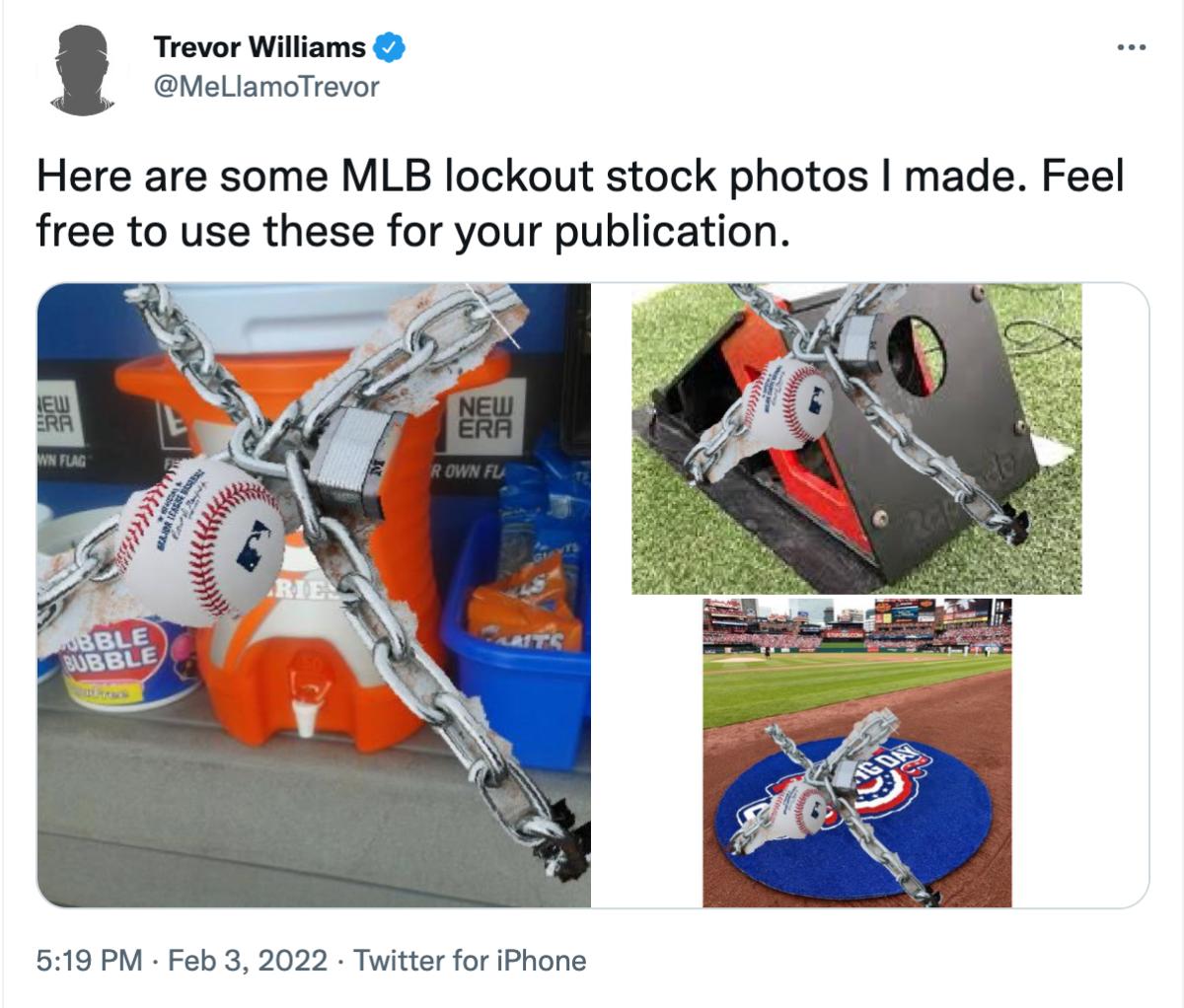
5. THE CLOSER from Emma Baccellieri
One feature that has made this work stoppage unique in baseball history from the beginning is the fact that it’s the first of the social media age—the first in which players can communicate with fans directly. We saw that most prominently at the start of the lockout, when many adopted the faceless player image as a profile picture to drive home the idea that the game is nothing without the players, as we discussed in this newsletter here. But the use of Twitter hadn’t really made waves again until yesterday—when the league’s request for federal mediation was announced just before news broke that the players would not be receiving a counterproposal.
“The only thing holding us back is the league dragging their heels on negotiations that will lead to lost games in 2022,” wrote Twins catcher Mitch Garver. “I feel bad for the fans mostly because I know all players want to be at ST in a few weeks, so when we’re ready to figure it out the players will be ready.” The Royals’ Whit Merrifield said that “actions speak louder than words” on the league’s perceived resistance to negotiating. You had Giants pitcher Alex Wood dragging the league for the pace of the process, and Mariners reliever Paul Sewald sharing his frustration and explained some of what the players are asking for.
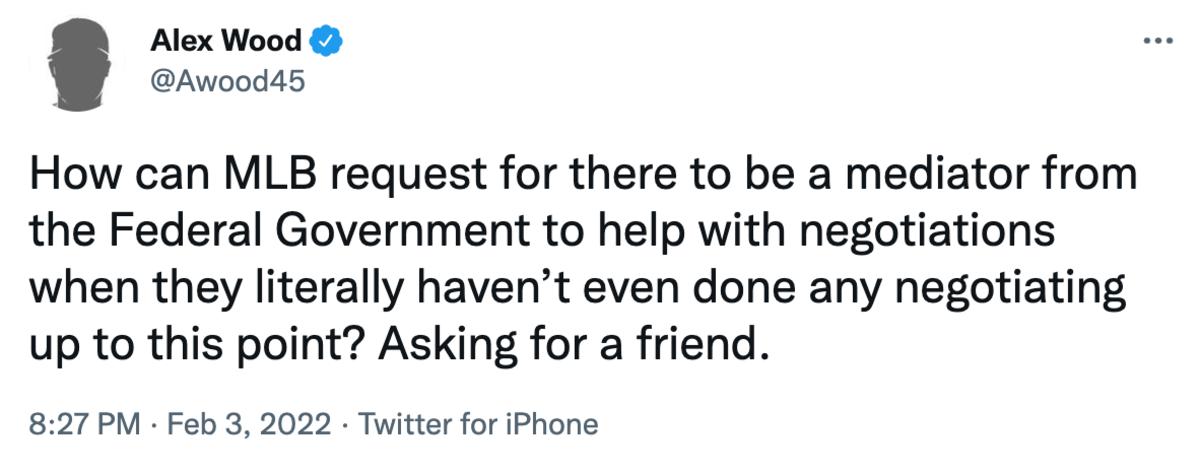
This player sentiment is limited by reach and by platform. But it’s still something that baseball didn’t have in past labor stoppages—players directly voicing their thoughts, answering questions from fans and ensuring that at least part of the public dialogue can be driven by them. If bargaining remains similarly rough in weeks to come, expect more of it.
That’s all from us today. We’ll be back in your inbox next Friday. In the meantime, share this newsletter with your friends and family, and tell them to sign up at SI.com/newsletters. If you have any questions or comments, shoot us an email at mlb@si.com.
